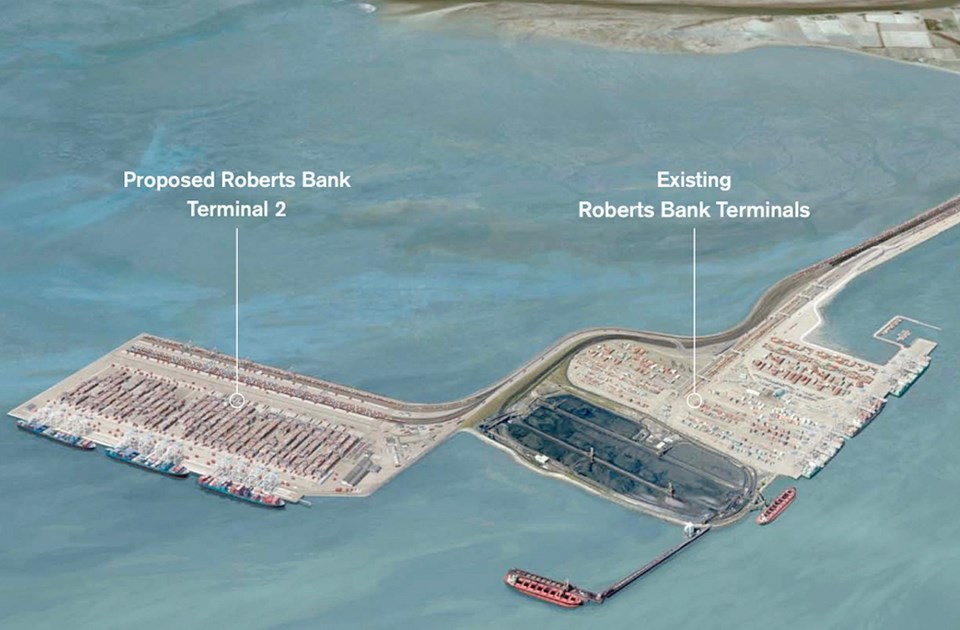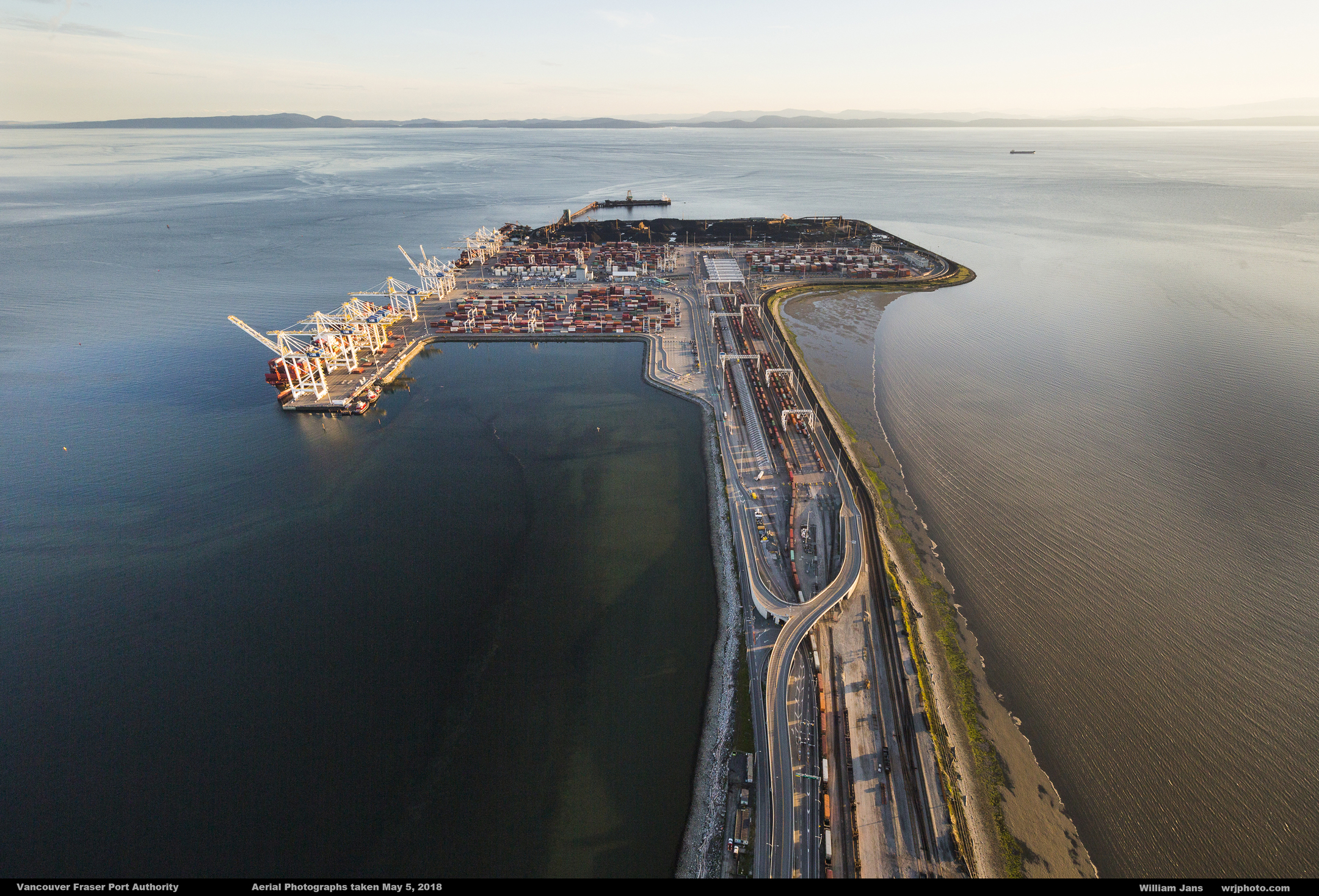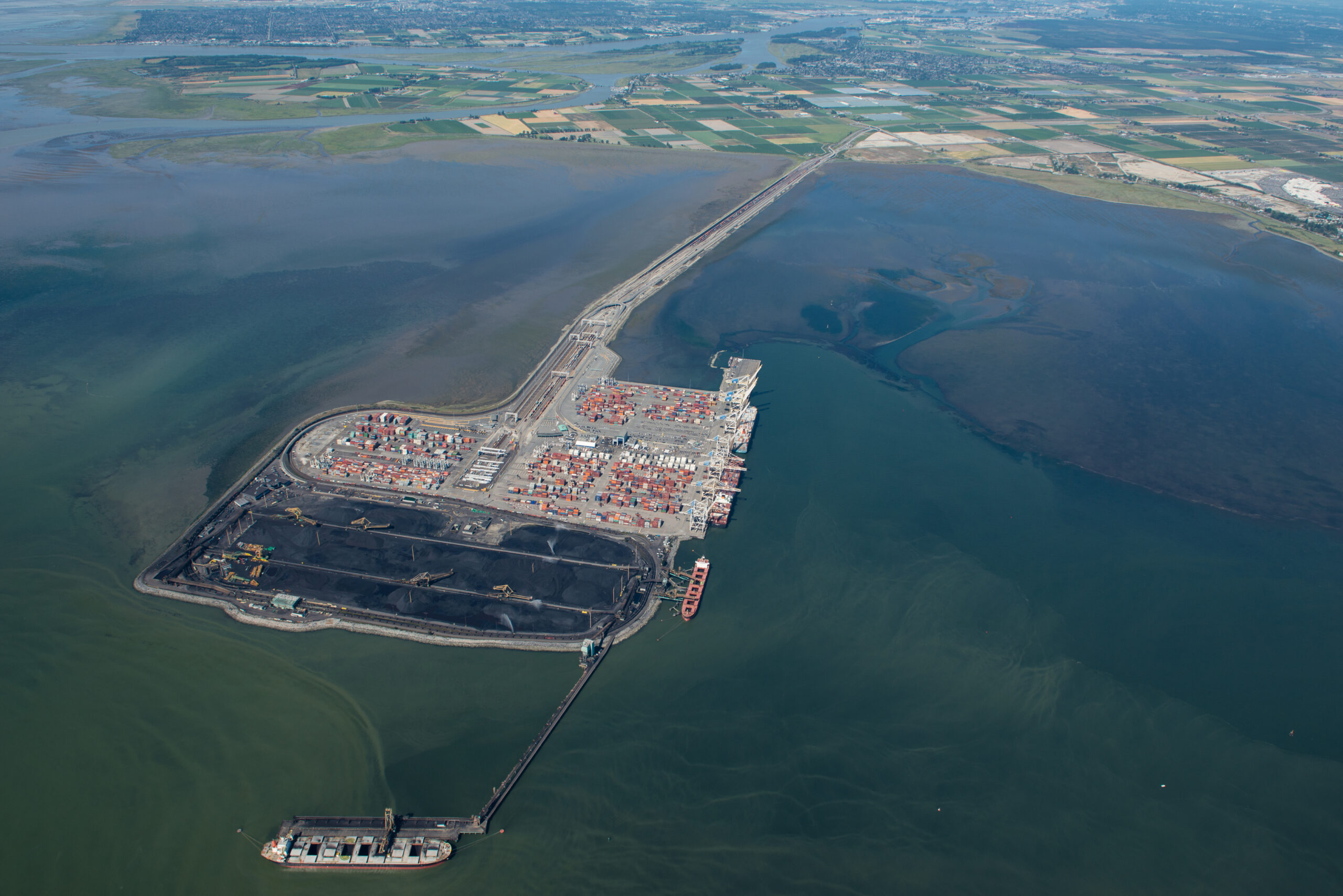
In a Nova Scotia research lab, the last hope for an ancient fish species
Racing against time, dwindling habitat and warming waters, scientists are trying to give this little-known...
After a year-long pause, the spotlight is back on a controversial proposal to double the size of the container terminal at Canada’s busiest port. The $3.5 billion expansion, called Robert Banks Terminal 2, is intended to increase capacity at the Delta, B.C., terminal.
While the Vancouver Fraser Port Authority, a federal Crown corporation, has been pushing for this project for more than a decade, many scientists, First Nations, conservation groups, locals and even one of the port’s own tenants have vocally opposed it.
This week, 12 scientists are voicing their concerns about the potential impacts of the terminal expansion on more than 100 at-risk species, including endangered Chinook salmon and southern resident killer whales, in a signed letter to the federal Minister of Environment and Climate Change Steven Guilbeault.
“If the recovery of Canada’s endangered and iconic wildlife is a priority for the government of Canada, as stated, then it must reject the proposed Terminal 2 project,” the letter reads.
If built, the new terminal would require an artificial island about the size of 150 football fields in the heart of the Fraser River estuary.

The Fraser River is the largest salmon-bearing river in Canada and it spills into the estuary, where juvenile salmon grow and adjust to saltwater life before making their way into the ocean. The estuary is also internationally recognized as an important bird and biodiversity area. Millions of birds stop at the estuary to rest and replenish partway through their journeys along the Pacific flyway, a migration route that extends from Alaska to Peru.
The project has been under federal environmental review since 2013 and it looks like it’s nearing the end of the process.
Right now observers, including the scientists who wrote the letter, are rushing to be part of a public comment period, which ends March 15. It’s likely to be their last chance to provide feedback on the project before a decision is made.
The environmental review timeline was paused when the previous environment minister asked the Vancouver Fraser Port Authority for more information about the project in 2020. The port authority responded in December of 2021, which triggered the public comment period.
If Guilbeault decides he has all of the information he needs to make a decision, the review process resumes and the minister must decide within 89 days whether he believes the project is likely to have “significant adverse environmental effects.”
But the buck doesn’t stop there. If the minister decides the project will have adverse impacts, the decision is passed to the Governor in Council — meaning the Governor General acting on the advice of the federal cabinet — to decide if negative environmental effects are justified if the project is in the public interest.
The scientists’ letter, dated Feb. 7, is part of a last-ditch effort to influence Guilbeault’s decision of whether to approve Roberts Bank Terminal 2.
At the heart of this decade-long debate is whether the port authority can fully offset the impacts of its concrete footprint on a unique and sensitive habitat. Critics say the importance of this habitat supersedes the importance of container capacity. But the port authority argues this project is essential to meet demand for importing goods like clothing, electronics and manufacturing parts from abroad, while exporting Canadian goods like pulp, lumber and crops.
In an email to The Narwhal a port authority spokesperson said it regularly commissions third-party forecasts which have concluded “container traffic to and from Canada’s West Coast is expected to grow significantly, well into the future,” and that’s why an expansion is necessary.
The port authority also said that they are confident the project is needed and can be built responsibly.
“Our response to government further reinforces our confidence that the project can be built in a responsible way that protects and enhances the environment, brings lasting benefits to Indigenous groups and local communities, creates tens of thousands of high-paying supply chain jobs and supports economic resiliency,” the spokesperson wrote.
In their letter, the scientists emphasize how the Federal Review Panel’s 2020 report on the project concluded the port expansion would have significant adverse and cumulative effects on Fraser Chinook salmon and significant adverse effects on endangered southern resident killer whales.
The Fraser estuary has lost 70 per cent of its salmon habitat due to development and the proposed project would deplete an additional 177 hectares. Southern resident killer whales are listed as endangered under the Species at Risk Act and depend on Chinook to survive. As of the fall of 2021, only 73 whales are left.
The 2020 report also concluded the project would likely have negative impacts on shorebirds, endangered barn owls, and Dungeness crab, in addition to First Nations and local communities due to air pollution, noise pollution and light pollution.
One of the letter’s signatories, professor Tara Martin at the University of British Columbia’s department of forest and conservation sciences, completed a study a few months after the impact assessment report that found 102 species in the Fraser estuary are at risk of extinction between now and 2045.
“Greater industrialization of the Salish Sea is compromising habitat within the estuary,” Misty MacDuffee, conservation biologist with Raincoast Conservation Foundation, told The Narwhal in an interview.
“It’s increasing the footprint in the heart of one of the most important estuaries on the entire West Coast of North America.”

Jonathan Wilkinson was environment minister when the review panel submitted its report in March 2020. That August, Wilkinson asked the port authority for more information on the port’s impact on salmon and killer whales, as well as more information on consulting with Indigenous Peoples, to inform his decision. The port authority’s response was published publicly in December 2021.
In its response to the minister, the port authority increased how much habitat it promised to restore to “offset” impacts of the expansion. It originally promised to offset 27 hectares, which the 2020 review panel concluded was “not sufficient” to offset the 177-hectares project. The port updated its promise to offset 86 hectares of habitat.
However, observers are not all convinced these offsets are enough.
Many of the offsetting sites are planned for Fraser tributaries, not the estuary itself, explained MacDuffee. This means the proposed measures don’t address scientists’ concern about juvenile salmon in the estuary making their way to the ocean.
The estuary provides juvenile salmon a place to feed and grow, and hide from predators “at a crucial stage in their life,” MacDuffee said.
Helping salmon at other life stages and other locations “doesn’t really make a difference” for juvenile salmon in the estuary, she explained. If juvenile salmon are not able to grow and develop in the estuary, then they aren’t able to make it to the ocean and mature into adults that eventually return to spawn.
“The panel concluded that the project will have adverse residual effects on juvenile Chinook salmon … I don’t think that the port’s response significantly changes any of that,” she concluded.
The port authority proposed further noise reduction measures and potentially reducing the project footprint by 14 hectares (about 26 football fields).
The port authority also proposed a breach either in the proposed terminal or in the causeway, which many conservationists and First Nations have been calling for for years. This culvert would allow juvenile salmon to pass underneath and more easily access the mudflats where they seek shelter.
“The port authority continues to investigate feasibility and consult with Indigenous groups and DFO to advance the conceptual design,” the port authority wrote in its response to the minister.
The port wrote that it expects impacts on juvenile salmon to be “negligible” based on modeling incorporating its offsetting measures.
MacDuffee said she supports creating breaches, but the proposed culvert is still “inadequate” to address Raincoast Conservation’s concerns for the safety of juvenile salmon as the port exists now, let alone with an expansion. And, southern resident killer whales depend on salmon for their survival.
“This population can’t absorb any further declines,” MacDuffee said.
According to a 2015 study, whose lead author Robert Lacy also signed the letter to the minister, increased shipping traffic has the potential to reduce southern resident killer whales’ feeding by almost 20 per cent. The study also found killer whales spend less time foraging or resting when they are surrounded by boats.
The port has committed to reducing noise levels during crucial whale activity periods and has argued there won’t be increased traffic at the terminal, just bigger container ships.
In the scientists’ letter to Guilbeault, they also express doubt about how successful the port’s offsetting measures will be. They cite a 2016 study that looked at areas in the Fraser estuary where people tried to restore habitat that had been damaged or destroyed. Only 33 per cent of these restored areas eventually functioned ecologically as planned. But even those sites didn’t support as many native species as they naturally would have before they were damaged.
“They can’t mitigate the consequences of this project,” MacDuffee said.

The cumulative impacts scientists, First Nations and stakeholders have identified in the Fraser River estuary are wide-ranging.
The 2020 review panel found the project would likely result in significant adverse and cumulative effects on traditional use of the land for the Tsawwassen and Musqueam Nations, as well as the Pacheedaht and Ditidaht First Nations.
“While the panel understands there would be relatively few ship movements associated with the project, each ship travelling through the shipping lanes causes an incremental effect on the ability of Indigenous groups to access sites where they conduct cultural activities,” the report reads.
Tsawwassen Chief Ken Baird, whose ancestral name is swənnəset, previously told The Narwhal he worries about the cumulative effects of industry on the water that is a life source for his people.
“It’s a real challenge to protect our land given all that is happening on the Fraser,” he said.
“[Industries] have an obligation to do enhancement to make up for their projects.”
Tsawwassen First Nation, Musqueam First Nation and Tsleil-Waututh First Nation are all in the affected area but did not respond in time for publication or said they did not have the capacity to respond.
Many other First Nations will also be impacted, and the port authority has consulted with 46 Indigenous groups, according to its submissions.
Tsawwassen First Nation drafted a health and food security study and submitted it to the port authority in response to the environment minister’s request for more information.The report situates the port expansion in the 150-year context of development and pollution the nation has experienced on its traditional territory.
“In the past, [Tsawwassen First Nation] members were able to walk and swim in the intertidal and marsh areas, and harvest crab, oysters and other shellfish on foot. This is no longer possible. The clay and silt is anoxic and appears heavily polluted,” the report reads.
In Musqueam’s response to the minister, it expressed, “Musqueam has repeatedly communicated that marine shipping effects, facility-specific effects and cumulative effects will contribute to significant adverse effects on Musqueam’s current use of lands and resources, including significant cumulative effects on cultural heritage.”
In addition, B.C.’s Ministry of Forests, Lands, Natural Resource Operations and Rural Development raised concerns the causeway interrupts sediment deposits at Roberts Bank, meaning the marsh could eventually be flooded, impacting wildlife and also putting communities at risk that rely on marshes for coastal flood mitigation.
In their report responding to the environment minister, the port authority emphasizes the need for the project.
“Canada’s trade competitiveness depends on the ability of Canada’s supply chain to provide reliable, cost-efficient access for importers and exporters,” according to the report.
“Federal and provincial governments have invested significantly in road and rail infrastructure that support the Port of Vancouver’s Roberts Bank terminals as a part of Canada’s west coast supply chain, but marine side capacity is urgently needed to support future trade.”
A port spokesperson told The Narwhal that their forecasts suggest that by 2030, 6.5 million containers will arrive at west coast ports, but as it stands only 5.8 million containers can be accommodated.
MacDuffee says this signals a broader “societal choice” of whether this demand really needs to be met.
“Do we really need to be consuming more?” she asked. “That’s a conversation that the public isn’t really having right now. Increasingly, we are aware of the costs of relying on global shipping to meet our economic needs.”
One of Port of Vancouver’s own tenants, Global Container Terminals, has been challenging the port authority’s statement on container capacity for years. The two companies have gone back and forth debating data and forecasts on how much capacity is truly needed. Global Container Terminals argues that other ongoing expansions at Prince Rupert and in Vancouver will meet the coast’s container capacity needs. The company has proposed its own smaller, single-berth expansion at Roberts Bank in competition with the Port of Vancouver’s Terminal 2 proposal.
When discussing capacity, there needs to be more public conversation around the activities of the port, Ken Ashley, a biologist, engineer and one of the signatories of the letter told The Narwhal. He pointed out that the port is home to Canada’s biggest coal export facility.
The port moved 13.5 million metric tonnes of coal in 2020, according to the port’s most recent statistics report.
Canada co-founded the Powering Past Coal Alliance with the United Kingdom in 2017, and Prime Minister Justin Trudeau has promised to ban coal exports. Coal-powered electricity is highly carbon intensive but still accounts for almost 40 per cent of the world’s electricity.
Ashley, who is director of the Rivers Institute at the British Columbia Institute of Technology, said he doesn’t know how Canada keeps a “straight face” talking about banning coal while facilitating the export of U.S. and Canadian coal.
Ashley wants to see a ban on coal exports not only to reduce emissions, but to free up space for The Port of Vancouver. This action would have to come straight from the federal government since cross-boundary exports are under federal jurisdiction. The port authority doesn’t decide what moves through the port.
Prime Minister Justin Trudeau’s mandate letter to environment minister Guilbeault directs him to work with the minister of international trade, export promotion, small business and economic development to “ban thermal coal efforts from and through Canada as swiftly as possible, and no later than 2030.”
A spokesperson from Environment and Climate Change Canada told The Narwhal in an email that “the Government of Canada is considering options to implement an export ban on thermal coal; however, an approach has not yet been determined.”
The ban wouldn’t affect metallurgical coal, predominantly mined in B.C.’s Elk Valley and used for steelmaking.
Ashley wondered if banning thermal coal exports could meet container capacity needs in Vancouver, but Marko Dekovic, vice president of public affairs for Global Container Terminals, said they investigated the possibility of repurposing Westshore, the coal export facility which neighbours the current container terminal at Roberts Bank, while generating their own alternative proposal to Terminal 2.
But Westshore “is unusable for containers,” Dekovic told The Narwhal in an interview.
“It would take a tremendous amount of restructuring and development. It’s not a viable solution,” he said.
While there is a lot of discussion about the capacity of the port, the impact assessment agency doesn’t consider whether a project is necessary — only what its environmental impacts will be.
Come March 15, observers will be left waiting to find out if the minister is satisfied with the port’s reponse. If he is, within three months they will find out if he is giving the project the green light.
MacDuffee said moving forward more work has to be done to consider the cumulative effects on the estuary to understand the true impacts of each new project proposal, rather than just considering the project in isolation.
She said Terminal 2 should be rejected and before any other proposal is considered, a Fraser estuary management plan should be created as well as an analysis of the cumulative effects of industry on the region.
“Any consideration of these huge industrial projects that have long-lasting implications [should] be evaluated within the context of a regional plan,” she said.
Get the inside scoop on The Narwhal’s environment and climate reporting by signing up for our free newsletter. On March 17, federal Conservative Leader Pierre Poilievre...
Continue reading
Racing against time, dwindling habitat and warming waters, scientists are trying to give this little-known...

From investigative reporting to stunning photography, we’ve been recognized with four 2024 CAJ Awards nods...

The Narwhal is expanding its reach on video platforms like YouTube and TikTok. First up?...
